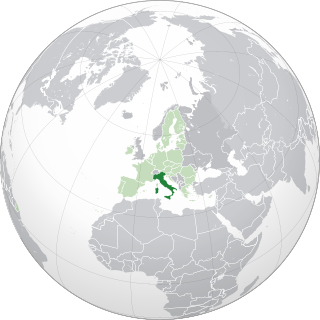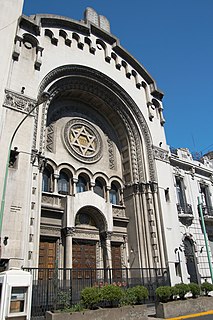Related Research Articles

Sephardi Jews, also known as Sephardic Jews, Sephardim, or Hispanic Jews by modern scholars, are a Jewish ethnic division originating from traditionally established communities in the Iberian Peninsula.
Judeo-Italian is an endangered Jewish language, with only about 200 speakers in Italy and 250 total speakers today. The language is one of the Italian dialects. Some words have Italian prefixes and suffixes added to Hebrew words as well as Aramaic roots.

The history of the Jews in Italy spans more than two thousand years to the present. The Jewish presence in Italy dates to the pre-Christian Roman period and has continued, despite periods of extreme persecution and expulsions, until the present. As of 2019, the estimated core Jewish population in Italy numbers around 45,000.

Elio Toaff was the Chief Rabbi of Rome from 1951 to 2002. He served as a rabbi in Venice from 1947, and in 1951 became the Chief Rabbi of Rome.

Moisés Ville is a small town (comuna) in the province of Santa Fe, Argentina, founded on 23 October 1889 by Eastern European and Russian Jews escaping pogroms and persecution. The original name intended for the town was Kiryat Moshe honoring Baron Maurice Moshe Hirsch, but the land agent who registered the settlement translated it to the French-like Moïsesville which was later hispanized to the current Moisés Ville. The town is located about 177 km (110 mi) from the provincial capital, in the San Cristóbal Department and 616 km (383 mi) from Buenos Aires. It had 2,572 inhabitants at the 2001 census [INDEC].

Shlomo Moshe Amar is the former Sephardi Chief Rabbi of Israel. He served as the Sephardic Chief Rabbi of Israel and the Rishon LeZion from 2003 to 2013. His Ashkenazi counterpart in those years was Rabbi Yona Metzger.

The Benveniste famiy is an old, noble, rich, and scholarly Jewish family of Narbonne, France and northern Spain from the 11th century. The family was present in the 11th to the 15th centuries in Hachmei Provence, France, Barcelona, Aragon and Castile Spain.
In Judaism, Nusach, plural nuschaot or nusachim refers to the exact text of a prayer service; sometimes the English word "rite" is used to refer to the same thing. Texts used by different communities include Nosach Teiman, Nusach Ashkenaz, Nusach Sefard, Nusach Edot Hamizrach, and Nusach Ari. In English, the word nusach means formulate, wording.

Eugenio Maria Zolli, born Israel Anton Zoller, was an Austro-Hungarian by birth, and an Italian doctorate professor of philosophy and author. Until converting from Judaism to Catholicism in February 1945, Zolli was the chief rabbi in Rome, Italy's Jewish community from 1940 to 1945. After the war, he taught philosophy at a number of institutions throughout Rome including the Sapienza University of Rome and Pontifical Biblical Institute.
Rap(p)aport, Rap(p)oport, Rappeport or Rapa Porto is a family name from an Ashkenazi (Jewish) Kohenitic pedigree. It takes its origins in the Rapa family of Porto Mantovano located in Province of Mantua, Italy.
Sarfati is a Sephardic Jewish surname.
Italian Jews or Roman Jews can be used in a broad sense to mean all Jews living or with roots in Italy, or, in a narrower sense, to mean the Italkim, an ancient community who use the Italian liturgy as distinct from the communities dating from medieval or modern times who use the Sephardic liturgy or the Nusach Ashkenaz.

Leon Modena or Yehudah Aryeh MiModena (1571–1648) was a Jewish scholar born in Venice to a family whose ancestors migrated to Italy after an expulsion of Jews from Spain.
Meir ben Isaac Katzenellenbogen was a German rabbi born in Katzenelnbogen.

The history of the Jews in Argentina goes back to the early sixteenth century, following the Jewish expulsion from Spain. Sephardi Jews fleeing persecution immigrated with explorers and colonists to settle in what is now Argentina. In addition, many of the Portuguese traders in the Viceroyalty of the Río de la Plata were Jewish. An organized Jewish community, however, did not develop until after Argentina gained independence from Spain in 1816. By mid-century, Jews from France and other parts of Western Europe, fleeing the social and economic disruptions of revolutions, began to settle in Argentina.
Isaac (Fernando) Cardoso was a Jewish physician, philosopher, and polemic writer.
Samuel Hirsch Margulies was an Orthodox rabbi and scholar. He was born in Berezhany, western Ukraine, and studied at the Breslau Jewish Theological Seminary and at the universities of Breslau and Leipzig, in Germany. He was rabbi in Hamburg (1885–1887), district rabbi of Hesse-Nassau, Germany, (1887–1890) and in 1890 was appointed chief rabbi of Florence, Italy. In 1899 he became principal of Italy’s only rabbinical seminary, the Collegio Rabbinico Italiano when it transferred from Rome to Florence. Margulies was a powerful spiritual force in Italy and trained many of its religious leaders. He founded and edited Rivista Israelitica, the learned journal published by the Seminary. His scholarly publications included an edition of Rabbi Saadiah’s Arabic translation of the Psalms.

Rabbi Samuel ben Abraham Aboab also known by his acronym RaSHA was a 17th century Western Sephardic rabbi and scholar, who is considered to be one of the greatest rabbinic sages of Italy. He served as the av bet din of Venice, where he rose to great prominence due to his vast knowledge of rabbinic literature. He is known for being an adamant opponent of the Sabbatean movement, and an early supporter of the old Yishuv.
Riccardo Reuven Pacifici was a rabbi from an Italian Jewish family of ancient Sephardic origins, with roots in the Jewish Spanish and rabbinical traditions.
Pardo is a very old surname of Sephardic Jewish origin and that derives from the Latin name Pardus which means leopard, to later change to Spanish Pardo meaning brown and referring to the color of the feline, in Latin "Panthera pardus" (leopard); nicknamed of this way because of those Jews who had the characteristic tan skin color. Israel was conquered by the Romans and many Jews began to adopt Latin names. This surname belongs to the Jewish people who settled in the Iberian Peninsula, being at that time the ancient Roman province of Hispania, which later with the arrival of Christianity, some Jews would convert to have a better social status, this being long before being forced to convert to Christianity by the Catholic kings or their subsequent expulsion. Today it is also found in countries such as Israel, Spain, Colombia, Greece, Turkey, the United States, Curaçao, Mexico, Peru, Argentina, Venezuela, Chile and Italy. Members of the Pardo family have distinguished themselves mainly in the Levante region of the Mediterranean.
References
- 1 2 3 4 Gottheil, R. & Elbogen, I. (1906). Pigo. In Jewish Encyclopedia. New York: Funk and Wagnalls.
- 1 2 3 4 Kiron, A., & Jerchower, S. (2003). The meaning of words: Marcus Jastrow and the making of rabbinic dictionaries. Judaica Online Exhibitions. Philadelphia: University of Pennsylvania.
- ↑ Bonfil, R. (2016, September 10). Venice: A symbol of Jewish history. Printed Matter. Retrieved from http://www.primolevicenter.org/printed-matter/venice-a-symbol-of-jewish-history/.
- ↑ Surnames of the Jews in Venezia. Jewish Genealogy in Italy.
- 1 2 Stow, K. (1995). The Jews in Rome (Vol. 1). Leiden: Brill.
- ↑ Kessin, Zachary. (Ed.) Table of names. Names of Jews in Rome in the 1550s. Accessed December 1, 2006.
- ↑ Surnames of the Jews in Rome. Jewish Genealogy in Italy. Accessed December 1, 2006.
- ↑ Rottenberg, D. (1986). Finding Our Fathers: A Guidebook to Jewish Genealogy. Baltimore: Genealogical Publishing Company.
- ↑ Italianos llegados a Buenos Aires (1882)
- ↑ Italianos llegados a Buenos Aires (1899)
| This page lists people with the surname Piccio. If an internal link intending to refer to a specific person led you to this page, you may wish to change that link by adding the person's given name(s) to the link. |